Panel Temperature Dependence on Atmospheric Parameters of an Operative Photovoltaic Park in Semi-Arid Zones Using Artificial Neural Networks
Abstract
1. Introduction
2. Materials and Methods
2.1. Study Area and Dataset
2.2. Artificial Neural Networks
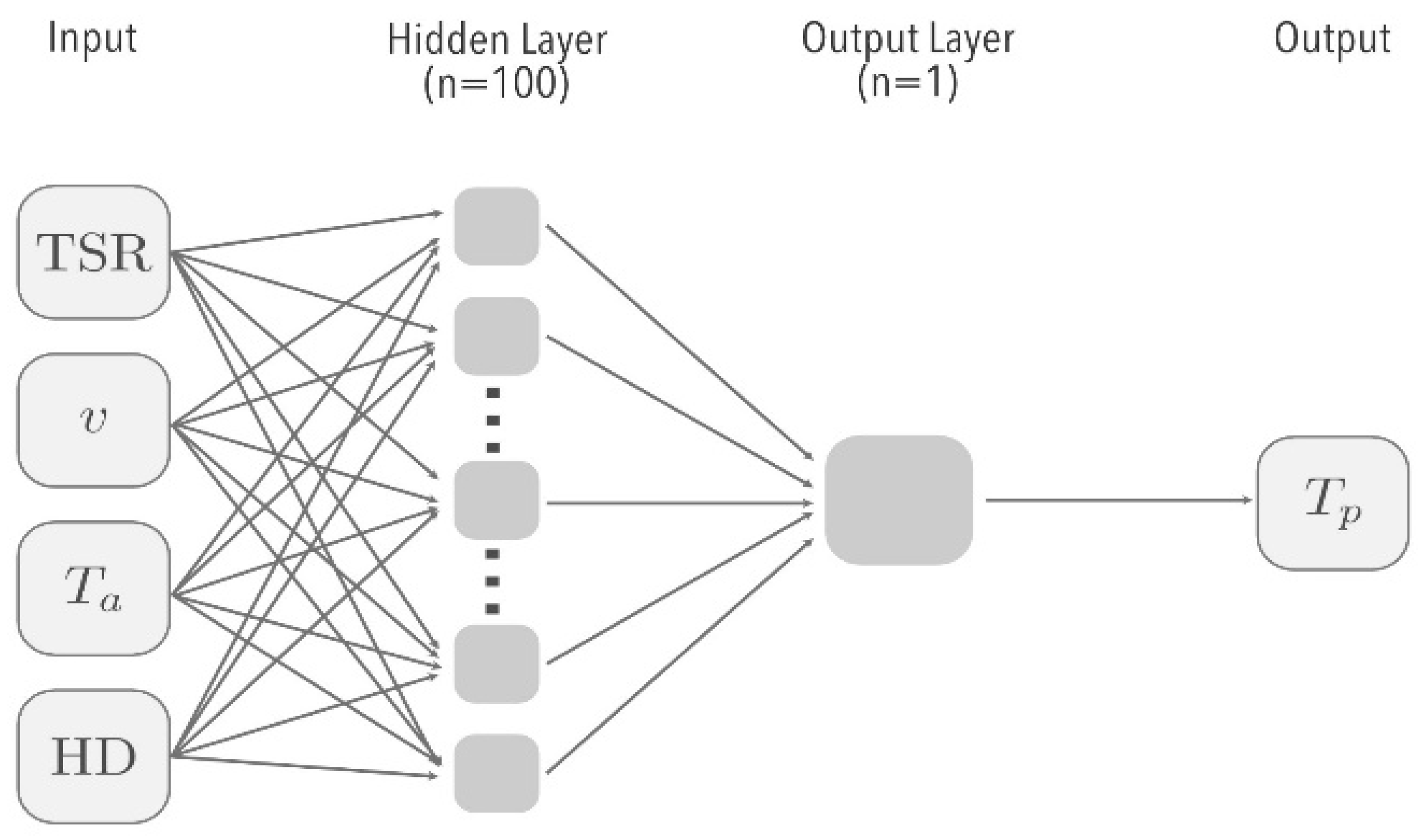
2.3. Deterministic Models
2.3.1. Standard Model
2.3.2. King’s Model
2.3.3. Faiman’s Model
2.3.4. Mattei’s Model
2.3.5. Skoplaki’s Model
3. Results and Discussion
3.1. Local Meteorological Characteristics and Temperature of the Panel
3.1.1. Solar Radiation
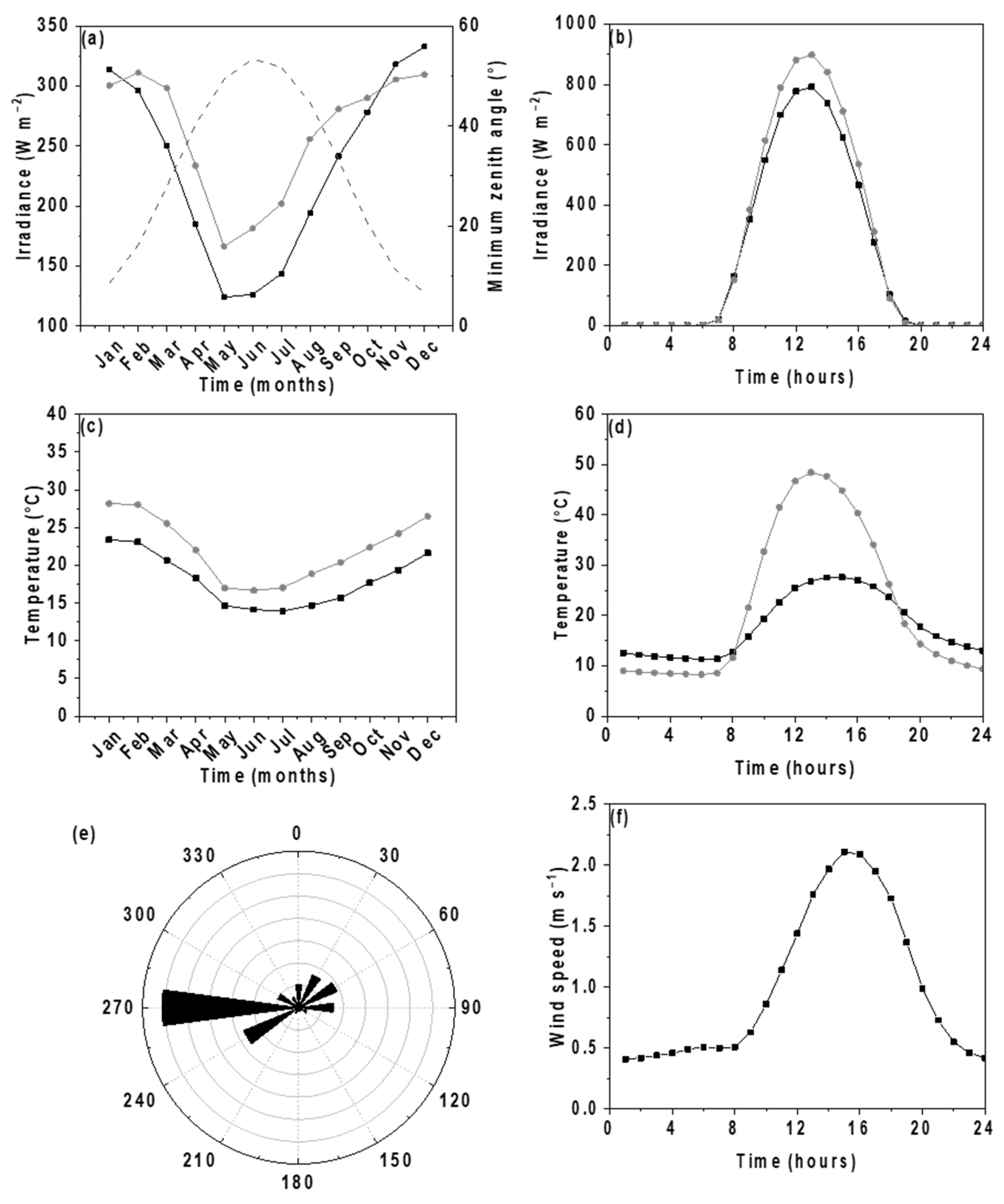
3.1.2. Air and Panel Temperature
3.1.3. Wind Velocity
3.1.4. Relationships between Atmospheric Variables and Panel Temperature

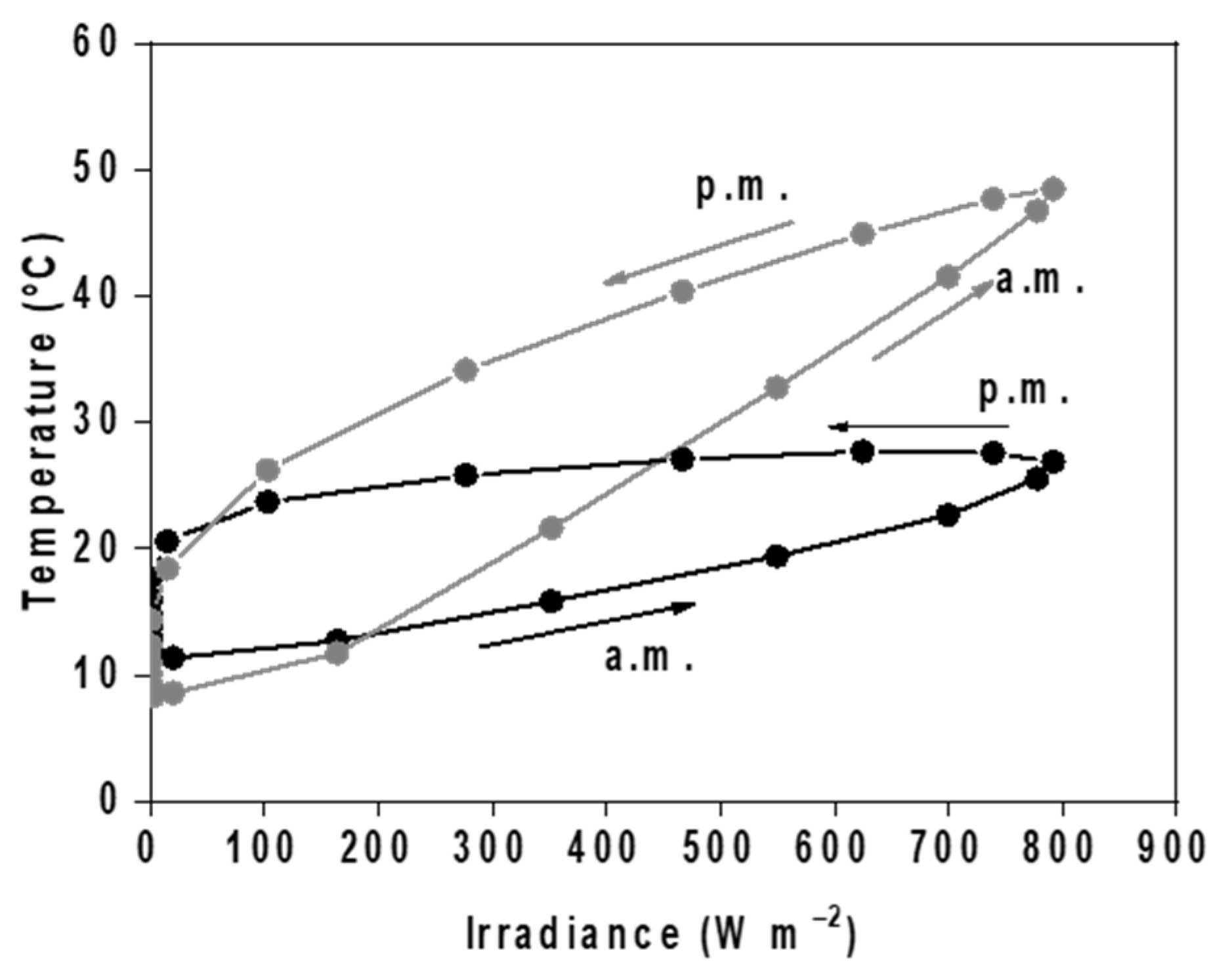
3.2. Prediction of the Panel Temperature
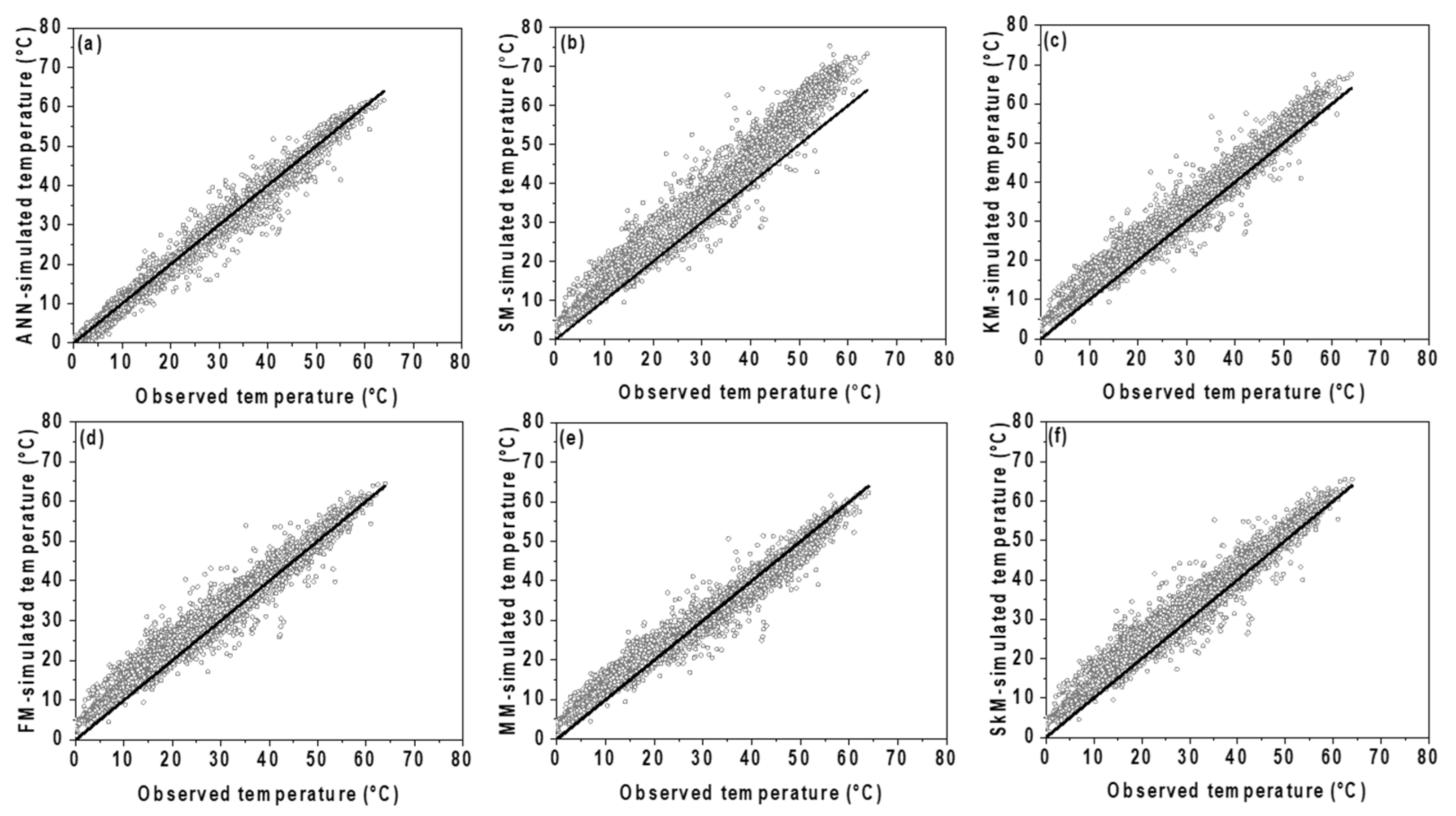

3.3. Sensitivity of Panel Temperature on Air Temperature, Tilted Solar Radiation, and Wind Speed
- ANNTSR: TSR is excluded;
- ANNT: is excluded;
- ANNv: is excluded.

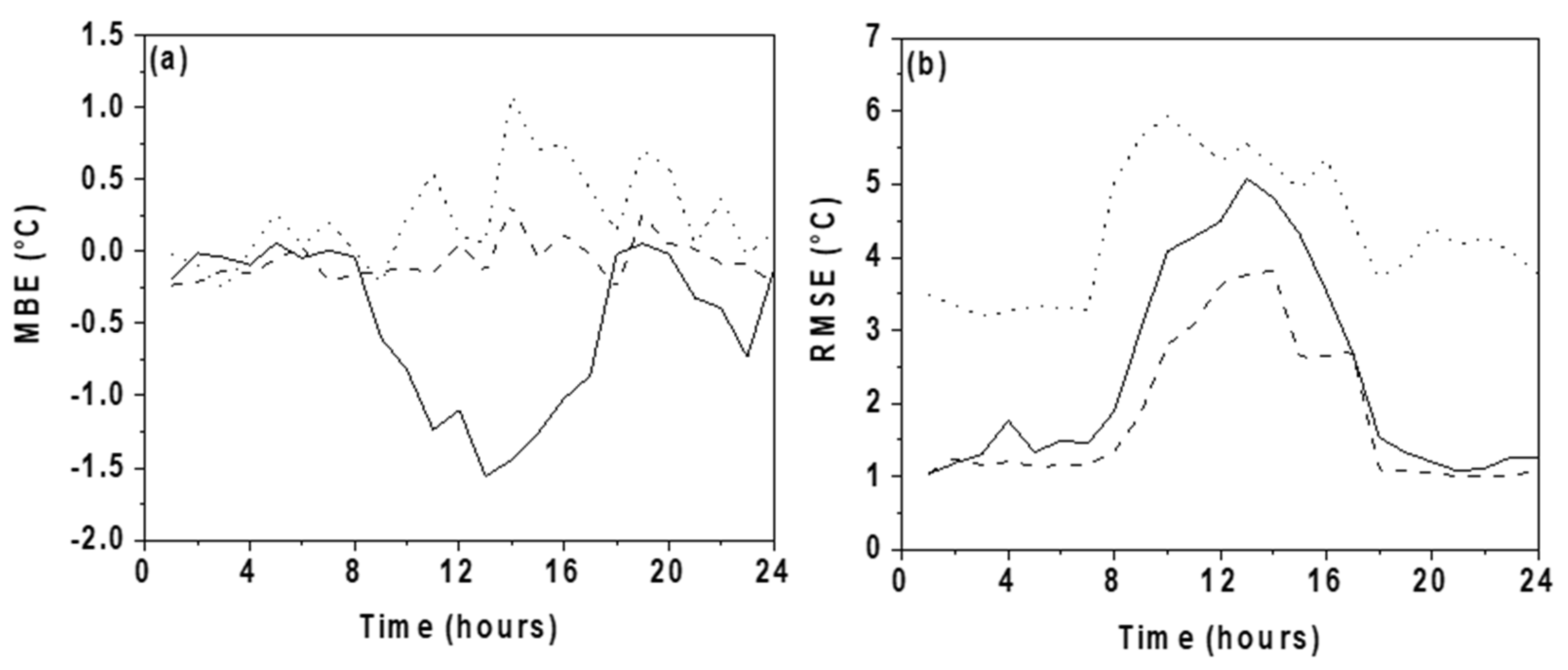
4. Conclusions
- (1)
- The ANN model presents a slight underestimation of the panel temperature; meanwhile, all deterministic models show a visible overestimation. The ANN reached the highest R, the smallest MBE, and the smallest RMSE.
- (2)
- The correlation coefficient was higher than 0.99 both for the ANN and deterministic models, meaning that all models can simulate the correlation between panel temperature and atmospheric variables.
- (3)
- The ANN is the model that best predicts the mean daily behavior of during most of the day, except in the afternoon, when the hourly RMSE is similar to Mattei’s and King’s models.
- (4)
- The ANN is the only model that can predict the night cooling of the panels.
- (5)
- During the day, all deterministic models, except the Standard model, exhibit a decrease in the RMSE when the wind blows, indicating that the inclusion of wind plays an important role in the estimation of . Among the deterministic models, Mattei’s model is the one that performs best.
- (6)
- Among the analyzed variables, has the highest impact on the panel temperature, followed by TSR and wind speed. This suggests that the atmospheric variable that influences the panel temperature for semi-arid regions with low humidity the most is air temperature.
Author Contributions
Funding
Data Availability Statement
Acknowledgments
Conflicts of Interest
References
- Tahmineh, M.; Wang, Y.; Hahn, Y. Graphene and its derivatives for solar cells applications. Nano Energy 2018, 47, 51–65. [Google Scholar]
- Coordinador Eléctrico Nacional. Available online: https://www.coordinador.cl/ (accessed on 10 April 2024).
- Henríquez, M.; Guerrero, L.; Fernández, A.; Fuentealba, E. Lithium nitrate purity influence assessment in ternary molten salts as thermal energy storage material for CSP plants. Renew. Energy 2020, 149, 940–950. [Google Scholar] [CrossRef]
- Cordero, R.; Damiani, A.; Laroze, D.; Macdonell, S.; Jorquera, J.; Sepúlveda, E.; Feron, S.; Llanillo, P.; Labbe, F.; Carrasco, J.; et al. Effects of soiling on photovoltaic (PV) modules in the Atacama Desert. Sci. Rep. 2018, 8, 13943. [Google Scholar] [CrossRef] [PubMed]
- El Amin, A.; Al-Maghrabi, M. The analysis of temperature effect for mc-Si photovoltaic cells performance. Silicon 2018, 10, 1551–1555. [Google Scholar] [CrossRef]
- Yolcan, O.O.; Kose, R. Photovoltaic module cell temperature estimation: Developing a novel expression. Sol. Energy 2023, 249, 1–11. [Google Scholar] [CrossRef]
- Chintapalli, N.; Sharma, K.M.; Bhattacharya, J. Linking spectral, thermal and weather effects to predict location-specific deviation from the rated power of a PV panel. Sol. Energy 2020, 208, 115–123. [Google Scholar] [CrossRef]
- Mattei, M.; Notton, G.; Cristofari, C.; Muselly, M.; Poggi, P. Calculation of the polycrystalline PV module temperature using a simple method of energy balance. Renew. Energy 2006, 31, 553–567. [Google Scholar] [CrossRef]
- May-Tzuc, O.; Bassam, A.; Mendez-Monroy, P.E.; Sanchez Dominguez, I. Estimation of the operating temperature of photovoltaic modules using artificial intelligence techniques and global sensitivity analysis: A comparative approach. J. Renew. Sustain. Energy 2018, 10, 033503. [Google Scholar] [CrossRef]
- Elminshawy, N.A.S.; El Ghandour, M.; Gad, H.M.; El-Damhogi, D.G.; El-Nahhas, K.; Addas, M.F. The performance of a buried heat exchanger system for PV panel cooling under elevated air temperature. Geothermics 2019, 82, 7–15. [Google Scholar] [CrossRef]
- Photovoltaic Array Performance Model. Available online: https://energy.sandia.gov/wp-content/gallery/uploads/043535.pdf (accessed on 22 July 2024).
- Skoplaki, E.; Boudouvis, A.; Palyvos, J. A simple correlation for the operating temperature of photovoltaics modules of arbitrary mounting. Sol. Energy Mater. Sol. Cells 2008, 52, 1393–1402. [Google Scholar] [CrossRef]
- Skoplaki, E.; Palyvos, J. Operating temperature of photovoltaic modules: A survey of pertinent correlations. Renew. Energy 2009, 34, 23–29. [Google Scholar] [CrossRef]
- Kurtz, S.; Whitfield, K.; Miller, D.; Joyce, J.; Wohlgemuth, J.; Kempe, M.; Dhere, N.; Bosco, N.; Sgonena, T. Evaluation of high-temperature exposure of rack-mounted photovoltaic modules. In Proceedings of the 34th IEEE Photovoltaic Specialist Conference, Philadelphia, PA, USA, 7–12 June 2009; pp. 2399–2404. [Google Scholar]
- Koehl, M.; Heck, M.; Weismeier, S.; Wirth, J. Modelling of the nominal operating cell temperature based on outdoor weathering. Sol. Energy Mater. Sol. Cells 2011, 95, 1638–1646. [Google Scholar] [CrossRef]
- Ayvazoğluyüksel, O.; Filik, Ü. Estimation methods of global solar radiation, cell temperature and solar power forecasting: A review and case study in Eskisehir. Renew. Sustain. Energy Rev. 2018, 91, 639–653. [Google Scholar] [CrossRef]
- Schwingshackl, C.; Petitta, M.; Wagner, J.; Belluardo, G.; Moser, D.; Castelli, M.; Zebisch, M.; Tetzlaff, A. Wind effect on PV module temperature: Analysis of different technics for an accurate estimation. Energy Procedia 2013, 40, 77–86. [Google Scholar] [CrossRef]
- Kaplani, E.; Kaplanis, S. Dynamic Electro-Thermal PV Temperature and Power Output Prediction Model for any PV Geometries in Free-Standing and BIPV Systems Operating under any Environmental Conditions. Energies 2020, 13, 4743. [Google Scholar] [CrossRef]
- Khandakar, A.; Chowdhury, M.; Kazi, M.; Benhmed, K.; Touati, F.; Al-Hitmi, M.; Gonzales, A. Machine learning based photovoltaics (PV) power prediction using different environmental parameters of Qatar. Energies 2019, 12, 2782. [Google Scholar] [CrossRef]
- Pasion, C.; Wagner, T.; Koscgnick, C.; Schuldt, S.; Williams, J.; Hallinam, K. Machine learning modeling of horizontal photovoltaic using weather and location data. Energies 2020, 13, 2570. [Google Scholar] [CrossRef]
- Yousif, J.; Kazem, H.; Alattar, N.; Elhassan, I. A comparison study based on artificial neural networks for assessing PV/T solar energy production. Case Stud. Therm. Eng. 2019, 13, 100407. [Google Scholar] [CrossRef]
- Rodríguez-Romero, J.A.; Mendoza-Castillo, D.I.; Reynel-Ávila, H.E.; de Haro-Del Rio, D.A.; González-Rodríguez, L.M.; Bonilla-Petriciolet, A.; Durán-Valle, C.J.; Camacho-Aguilar, K.I. Preparation of a new adsorbent for the removal of arsenic and its simulation with artificial neural network-based adsorption models. J. Environ. Chem. Eng. 2020, 8, 103928. [Google Scholar] [CrossRef]
- Manobel, B.; Sehnke, F.; Lazzus, J.; Salfate, I.; Felder, M.; Montecinos, S. Wind turbine power curve modeling based on Gaussian Processes and Artificial Neural Networks. Renew. Energy 2018, 125, 1015–1020. [Google Scholar] [CrossRef]
- Salfate, I.; Marin, J.C.; Cuevas, O.; Montecinos, S. Improving wind speed forecasts from the Weather Research and Forecasting model at a wind farm in the semiarid Coquimbo region in central Chile. Wind Energy 2020, 23, 1939–1954. [Google Scholar] [CrossRef]
- Barrera, J.M.; Reina, A.; Maté, A.; Trulijjo, J.C. Solar Energy Prediction Model Based on Artificial Neural Networks and Open Data. Sustainability 2020, 12, 6915. [Google Scholar] [CrossRef]
- Lo Brano, V.; Ciulla, G.; Di Falco, M. Artificial Neural Networks to Predict the Power Output of a PV Panel. Int. J. Photoenergy 2014, 2014, 193083. [Google Scholar] [CrossRef]
- Fouilloy, A.; Voyant, C.; Notton, G.; Motte, F.; Paoli, C.; Nivet, M.; Guillot, E.; Duchaud, J. Solar irradiation prediction with machine learning: Forecasting models selection method depending on weather variability. Energy 2018, 165, 620–629. [Google Scholar] [CrossRef]
- Sulaiman, S.I.; Zainol, N.Z.; Othman, Z.; Zainuddin, H. Cuckoo Search for Determining Artificial Neural Network Training Parameters in Modeling Operating Photovoltaic Module Temperature. In Proceedings of the International Conference on Modelling, Identification & Control, Grindelwald, Switzerland, 23–25 February 2004. [Google Scholar]
- Ciulla, G.; Lo Brano, V.; Moreci, E. Forecasting the Cell Temperature of PV Modules with an Adaptive System. Int. J. Photoenergy 2013, 2013, 192854. [Google Scholar] [CrossRef]
- Dzib, J.T.; Moo, E.J.A.; Bassam, A.; Flota-Bañuelos, M.; Soberanis, E.; Ricaldi, L.J.; López-Sánchez, J. Photovoltaic Module Temperature Estimation: A Comparison between Artificial Neural Networks and Adaptive Neuro Fuzzy Inference Systems Models. In Intelligent Computing Systems, ISICS, Communications in Computer and Information Science; Martin-Gonzalez, A., Uc-Cetina, V., Eds.; Springer: Cham, Switzerland, 2016. [Google Scholar]
- Fernández, E.; Almonacid, F.; Rodrigo, P.; Perez-Higueras, P. Calculation of the cell temperature of a high concentrator photovoltaic (HCPV) module: A Study of Comparison of Different Methods. Sol. Energy Mater. Sol. Cells 2014, 121, 144–151. [Google Scholar] [CrossRef]
- Chayapathy, V.; Anitha, G.; Raghavendra, S.; Vijaykumar, R. Solar panel temperature prediction by artificial neural networks. In Proceedings of the 4th International Conference on Recent Trends on Electronic, Information, Communication & Technology, Bengaluru, India, 17–18 May 2019. [Google Scholar]
- Garreaud, R.; Muñoz, R. The low-level jet off West coast of subtropical South America: Structure and variability. Mon. Weather Rev. 2005, 133, 2246–2261. [Google Scholar] [CrossRef]
- Montecinos, S.; Gutiérrez, J.; López-Cortés, F.; López, D. Climatic characteristics of the semi-arid Coquimbo Region in Chile. J. Arid Environ. 2016, 126, 7–11. [Google Scholar] [CrossRef]
- Kalthoff, N.; Bischoff-Gauss, I.; Fiebig-Wittmaack, M.; Fiedler, F.; Thürauf, J.; Novoa, E.; Pizarro, C.; Gallardo, L.; Rondanelli, R.; Kohler, M. Mesoscale wind regimes in Chile at 30 °C. J. Appl. Meteorol. 2002, 41, 953–970. [Google Scholar] [CrossRef]
- Olivares, S.; Squeo, F. Patrones fenológicos en especies arbustivas del desierto costero del norte-centro de Chile (Phenological stock in shrub species of the coastal desert of north-central Chile). Rev. Chil. Hist. Nat. 1999, 72, 353–370. [Google Scholar]
- Kalthoff, N.; Fiebig-Wittmaack, M.; Meissner, C.; Kohler, M.; Uriarte, M.; Bischoff-Gauss, I.; Gonzales, E. The energy balance, evapotranspiration and nocturnal dew deposition of an arid valley in the Andes. J. Arid Environ. 2006, 65, 420–443. [Google Scholar] [CrossRef]
- Centro de Estudios Avanzados en Zonas Áridas. Available online: www.ceazamet.cl (accessed on 10 April 2024).
- Arifin, F.; Robbani, H.; Annisa, T.; Ma’arof, N. Variations in the number of layers and the number of neurons in artificial neural networks: Case study of pattern recognition. J. Phys. Conf. Ser. 2019, 1413, 012016. [Google Scholar] [CrossRef]
- Fausset, L. Simple Neural Nets for Pattern Classification. In Fundamentals of Neural Networks: Architectures, Algorithms, and Applications; Prentice-Hall, Inc.: Hoboken, NJ, USA, 2014. [Google Scholar]
- Goh, A. Back propagation neural networks for modeling complex systems. Eng. Appl. Artif. Intell. 1995, 9, 143–151. [Google Scholar] [CrossRef]
- Markvart, T. Environmental Impacts of Photovoltaics. In Solar Electricity, 2nd ed.; John Wiley & Sons Ltd.: Chichester, UK, 2000. [Google Scholar]
- Faiman, D. Assessing the outdoor operating temperature of photovoltaic modules. Prog. Photovolt. 2008, 16, 307–315. [Google Scholar] [CrossRef]
- Jones, A.; Underwood, C. A thermal model for photovoltaic system. Sol. Energy 2001, 70, 349–359. [Google Scholar] [CrossRef]
- Sandnes, B.; Rekstadt, J. A photovoltaic/thermal (PV/T) collector with polymer absorber plate, experimental study and analytical model. Sol. Energy 2002, 72, 63–73. [Google Scholar] [CrossRef]
- Brasseur, G.; Solomon, S. Solar radiation at the top of the Atmosphere. In Aeronomy of the Middle Atmosphere: Chemistry and Physics of the Stratosphere and Mesosphere; Springer: Dordrecht, The Netherlands, 2005. [Google Scholar]
- Husain, M.A.; Khan, Z.A.; Tariq, A. A novel solar PV MPPT scheme utilizing the difference between panel and atmospheric temperature. Renew. Energy Focus 2017, 19–20, 11–22. [Google Scholar]
- Zhao, B.; Hu, M.; Ao, X.; Huang, X.; Ren, X.; Pei, G. Conventional photovoltaic panel for nocturnal radiative cooling and preliminary performance analysis. Energy 2019, 175, 677–686. [Google Scholar] [CrossRef]
- Ma, T.; Yang, H.; Lu, L. Long term performance analysis of a standalone photovoltaic system under real conditions. Appl. Energy 2017, 201, 320–331. [Google Scholar] [CrossRef]
- Du, Y.; Fell, C.J.; Duck, B.; Chen, D.; Liffman, K.; Zhang, Y.; Gu, M.; Zhu, Y. Evaluation of photovoltaic panel temperature in realistic scenarios. Energy Convers. Manag. 2016, 108, 60–67. [Google Scholar] [CrossRef]
- Cava, W.; Bauer, C.; Moore, J.H.; Pendergrass, S.A. Interpretation of machine learning predictions for patient outcomes in electronic health records. Proc. AMIA Annu. Symp. 2020, 2019, 572–581. [Google Scholar]

| Model | Atmospheric Variables | R | MBE (°C) | RMSE (°C) |
|---|---|---|---|---|
| ANN | - | 1.00 | −0.11 | 1.59 |
| SM | Ta, TSR | 0.99 | 4.72 | 5.83 |
| KM | Ta, TSR, v | 0.99 | 3.23 | 3.98 |
| FM | Ta, TSR, v | 0.99 | 2.44 | 3.56 |
| MM | Ta, TSR, v | 0.99 | 1.85 | 3.30 |
| SkM | Ta, TSR, v | 0.99 | 2.70 | 3.73 |
| Variable | EII | PFI |
|---|---|---|
| Air temperature | 0.48 | 0.51 |
| Tilted solar radiation | 0.30 | 0.47 |
| Wind speed | 0.22 | 0.02 |
Disclaimer/Publisher’s Note: The statements, opinions and data contained in all publications are solely those of the individual author(s) and contributor(s) and not of MDPI and/or the editor(s). MDPI and/or the editor(s) disclaim responsibility for any injury to people or property resulting from any ideas, methods, instructions or products referred to in the content. |
© 2024 by the authors. Licensee MDPI, Basel, Switzerland. This article is an open access article distributed under the terms and conditions of the Creative Commons Attribution (CC BY) license (https://creativecommons.org/licenses/by/4.0/).
Share and Cite
Montecinos, S.; Rodríguez, C.; Torrejón, A.; Cortez, J.; Jaque, M. Panel Temperature Dependence on Atmospheric Parameters of an Operative Photovoltaic Park in Semi-Arid Zones Using Artificial Neural Networks. Energies 2024, 17, 5844. https://doi.org/10.3390/en17235844
Montecinos S, Rodríguez C, Torrejón A, Cortez J, Jaque M. Panel Temperature Dependence on Atmospheric Parameters of an Operative Photovoltaic Park in Semi-Arid Zones Using Artificial Neural Networks. Energies. 2024; 17(23):5844. https://doi.org/10.3390/en17235844
Chicago/Turabian StyleMontecinos, Sonia, Carlos Rodríguez, Andrea Torrejón, Jorge Cortez, and Marcelo Jaque. 2024. "Panel Temperature Dependence on Atmospheric Parameters of an Operative Photovoltaic Park in Semi-Arid Zones Using Artificial Neural Networks" Energies 17, no. 23: 5844. https://doi.org/10.3390/en17235844
APA StyleMontecinos, S., Rodríguez, C., Torrejón, A., Cortez, J., & Jaque, M. (2024). Panel Temperature Dependence on Atmospheric Parameters of an Operative Photovoltaic Park in Semi-Arid Zones Using Artificial Neural Networks. Energies, 17(23), 5844. https://doi.org/10.3390/en17235844







